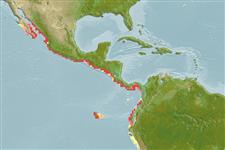Actinopterygii (ray-finned fishes) >
Perciformes (Perch-likes) >
Haemulidae (Grunts) > Haemulinae
Etymology: Pomadasys: Greek, poma, -atos = cover, operculum + Greek, dasys = with hair (Ref. 45335).
Environment / Climate / Range
Ecology
Marine; demersal; depth range 10 - 60 m (Ref. 91172). Tropical, preferred ?; 27°N - 16°S, 115°W - 74°W
Eastern Pacific: Gulf of California to Peru.
Size / Weight / Age
Maturity: Lm ? range ? - ? cm
Max length : 39.0 cm TL male/unsexed; (Ref. 55763); common length : 25.0 cm TL male/unsexed; (Ref. 55763)
Body oblong, moderately compressed, and not very deep (depth contained 2.3 to 2.5 times in standard length); mouth moderate sized and terminal, its posterior end located at the same level as the anterior rim of the eye; first gill arch with 20 to 23 gill rakers; dorsal fin deeply notched, with 12 to 13 spines and 13 soft rays (XII-XIII, 13); pectoral fins very long (contained 2.7 to 3.3 times in standard length), reaching origin of anal fin; second anal spine much stronger and longer than third; back gray; belly silvery; posterior angle of operculum with a very distinct black spot preceded by a green area (Ref. 55763).
Adults inhabit sandy bottoms of coastal waters (Ref. 9114). Marketed fresh (Ref. 9114).
Life cycle and mating behavior
Maturity | Reproduction | Spawning | Eggs | Fecundity | Larvae
Oviparous, distinct pairing during breeding (Ref. 205).
McKay, R.J. and M. Schneider, 1995. Haemulidae. Burros, corocoros, chulas, gallinazos, roncos. p. 1136-1173. In W. Fischer, F. Krupp, W. Schneider, C. Sommer, K.E. Carpenter and V. Niem (eds.) Guia FAO para Identification de Especies para lo Fines de la Pesca. Pacifico Centro-Oriental. 3 Vols. FAO, Rome. (Ref. 9114)
IUCN Red List Status (Ref. 115185)
CITES (Ref. 94142)
Not Evaluated
Threat to humans
Harmless
Human uses
Fisheries: minor commercial
More information
ReferencesAquacultureAquaculture profileStrainsGeneticsAllele frequenciesHeritabilityDiseasesProcessingMass conversion
Tools
Can't connect to MySQL database fbquizv2. Errorcode: Too many connections
